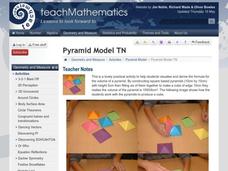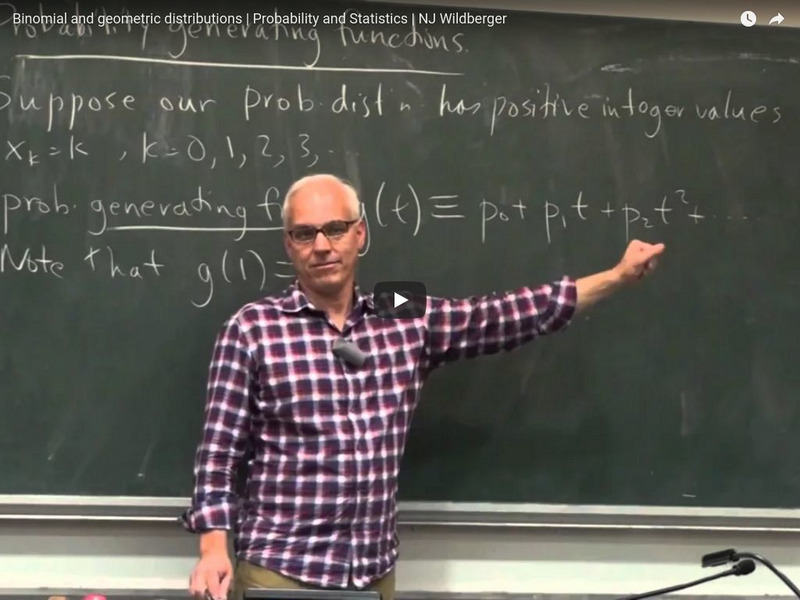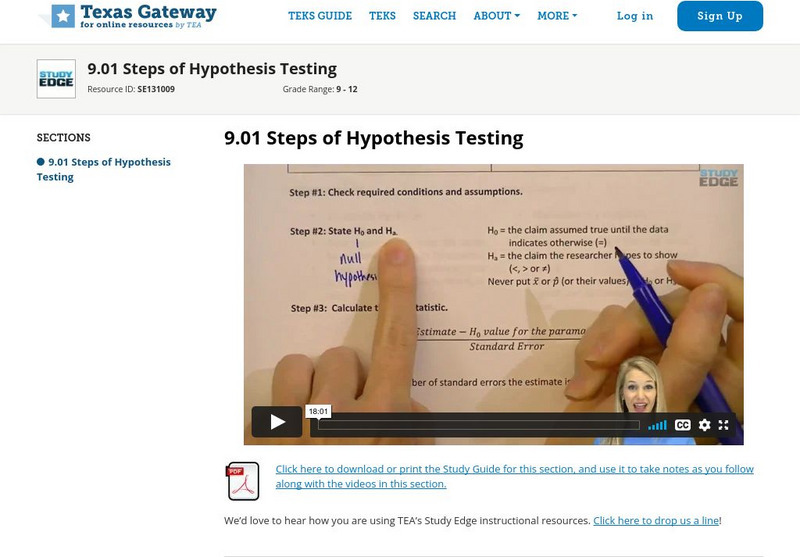TED-Ed
Music and Math: The Genius of Beethoven
Math will resonate with your young artists and musicians when they learn that a mathematical formula describes a musical sound that is pleasing to our ears. Beethoven uses the certainty of mathematics to convey emotion and...
TED-Ed
The Time Value of Money
Your car-loving or money-loving learners will enjoy this quick video on the time value of money (interest) presented in two scenarios about investing a bonus check to increase its future value in order to buy a favorite car. The formula...
TED-Ed
A-rhythm-etic. The Math Behind the Beats
Your learners will dance in their seats as this talented drummer connects math to music in a short video clip. Clayton Cameron shows how math puts the "cool" in various genres of music, including jazz, hip-hop, pop,...
National Science Foundation
Science of NFL Football: Geometric Shapes
Ever wonder why a football has such an unsual shape? Find out with this video from the Science of Football colelction that examines how the geometric properties of a football make it perfectly suited for being thrown accurately over...
Jim Noble, Richard Wade & Oliver Bowles
Pyramid Model
Seeking to derive the formula for the volume of a square pyramid, geometry learners construct six square based pyramids that, when pieced together properly, form a cube. Two short videos demonstrate the relationship...
Scholastic
Study Jams! Measure Length
Mia's pet lizard has grown a lot since he was a baby and she needs help measuring his length now that he's an adult. After choosing the best tool for the job, RJ goes step by step through the measurement process, modeling how to use both...
Scholastic
Study Jams! Place Value
Looking at large numbers can intimidate many young mathematicians. Use Zoe's place value machine to help learners understand the meaning behind each digit in a whole number. After learning about the ones, tens, and hundreds places,...
Scholastic
Study Jams! Relate Addition & Subtraction
Understanding the inverse relationship between addition and subtraction is essential for developing fluency in young mathematicians. Zoe and RJ explain how three numbers can form fact families that make two addition and two subtraction...
Scholastic
Study Jams! Relate Multiplication & Division
Sometimes the easiest way to understand division is to look at it as multiplication. Show your mathematicians that every problem can be written backward to make it easier for them. The video explains how the relationship between...
Virtual Nerd
What are Quadrants in the Coordinate Plane?
The teacher diagrams a coordinate plane and identifies the four quadrants. He labels the quadrants with numbers. Then he illustrates a table to identify the positive or negative value of the x-coordinate and the y-coordinate and...
Virtual Nerd
How Do You Subtract a Negative Number from a Positive Number?
Subtracting an integer is as simple as adding the opposite value. Watch this video to see an example of how to change the signs and then add the two integers. Use this as a review after you have taught this valuable skill to your middle...
Educreations
Dividing Using Friendly Numbers
Simplify division for young mathematicians by teaching them how to use friendly numbers when finding quotients. Three examples are presented in this instructional video that models the process of breaking large dividends into sums of...
Virtual Nerd
What is Absolute Value?
As long as you keep in mind that there is no such thing as negative distance, then you will know the meaning of absolute value. The teacher writes on a white board to explore integers on a number line, give a definition of absolute...
Khan Academy
Khan Academy: Statistics: Small Sample Hypothesis Test
Video demonstrates using t-statistics to answer a question involving hypothesis testing with a small sample. Explains how to read a t-table and use it for a one-tailed test. [9:04]
Khan Academy
Khan Academy: Statistics: Anova 3 Hypothesis Test With F Statistic
Video demonstrates how to calculate an F-statistic and use the F-distribution to determine whether to accept or reject a null hypothesis. [10:14]
University of New South Wales (Australia)
University of New South Wales: Prob Stats6: Binomial and Geometric Distributions
In this lecture for an introductory probability and statistics course, the instructor goes over binomial and geometric distributions, as well as sign tests. [52:21]
Texas Education Agency
Texas Gateway: Study Edge Statistics: Hypothesis Test for One Proportion, Part 1
This lesson looks at a hypothesis test for one proportion in a problem about Snapchat use among teenagers. Includes downloadable study guide with exercises - guide also covers other topics. [11:34]
Texas Education Agency
Texas Gateway: Study Edge Statistics: Steps of Hypothesis Testing
This lesson explains the process for doing a hypothesis test about an unknown population parameter by examining required conditions and assumptions, calculating the test statistics, finding the p-value, and stating the conclusion....
Khan Academy
Khan Academy: Statistics: Large Sample Proportion Hypothesis Test
Video gives an example of a hypothesis test calculation involving the proportion of the population that has internet access given a large sample size. Discusses finding a critical z-score to determine whether to reject the null...
Khan Academy
Khan Academy: Statistics: Hypothesis Test Comparing Population Proportions
Video demonstrates the steps of a hypothesis test involving comparing population proportions. It shows setting up the null and alternative hypotheses and the steps used to calculate a z-statistic for the difference of the proportions and...
Khan Academy
Khan Academy: Statistics: Hypothesis Testing and P Values
Video gives example of hypothesis testing with an example related to medical testing. Includes setting up a null hypothesis and an alternative hypothesis. [11:26]
Khan Academy
Khan Academy: Statistics: Hypothesis Test for Difference of Means
Video demonstration of setting up a hypothesis test and calculating whether the difference of sample means of an experiment falls within a 5% significance level and using that to determine whether to accept or reject the null hypothesis....
Khan Academy
Khan Academy: Statistics and Probability: Study Design: Statistical Questions
Video explaining what the characteristics of a good statistical question are. [9:33]
Khan Academy
Khan Academy: Fundamentals: Bayes' Theorem
In this Wireless Philosophy video, Ian Olasov (CUNY) introduces Bayes' Theorem of conditional probability and the related Base Rate Fallacy. [6:20]





















